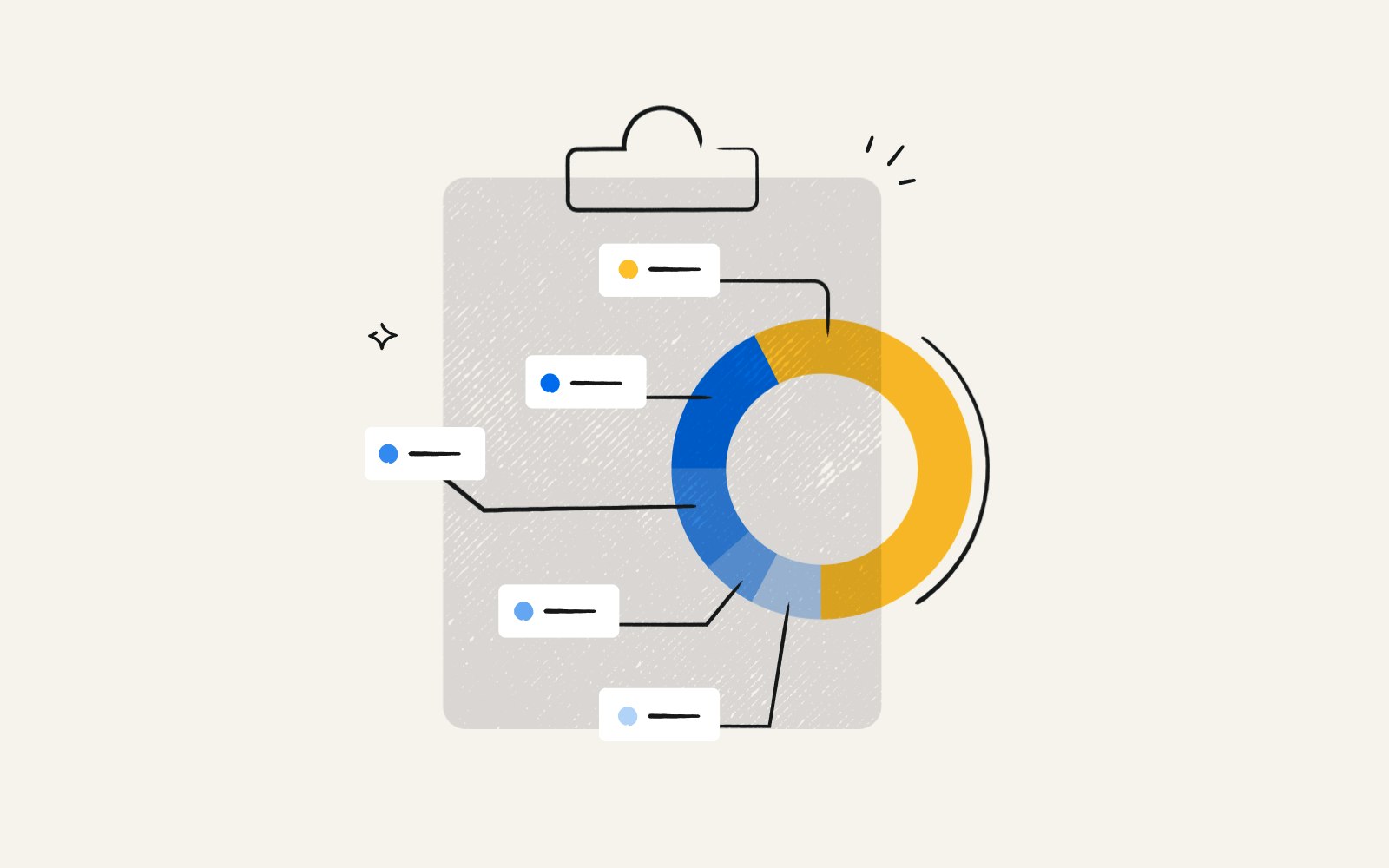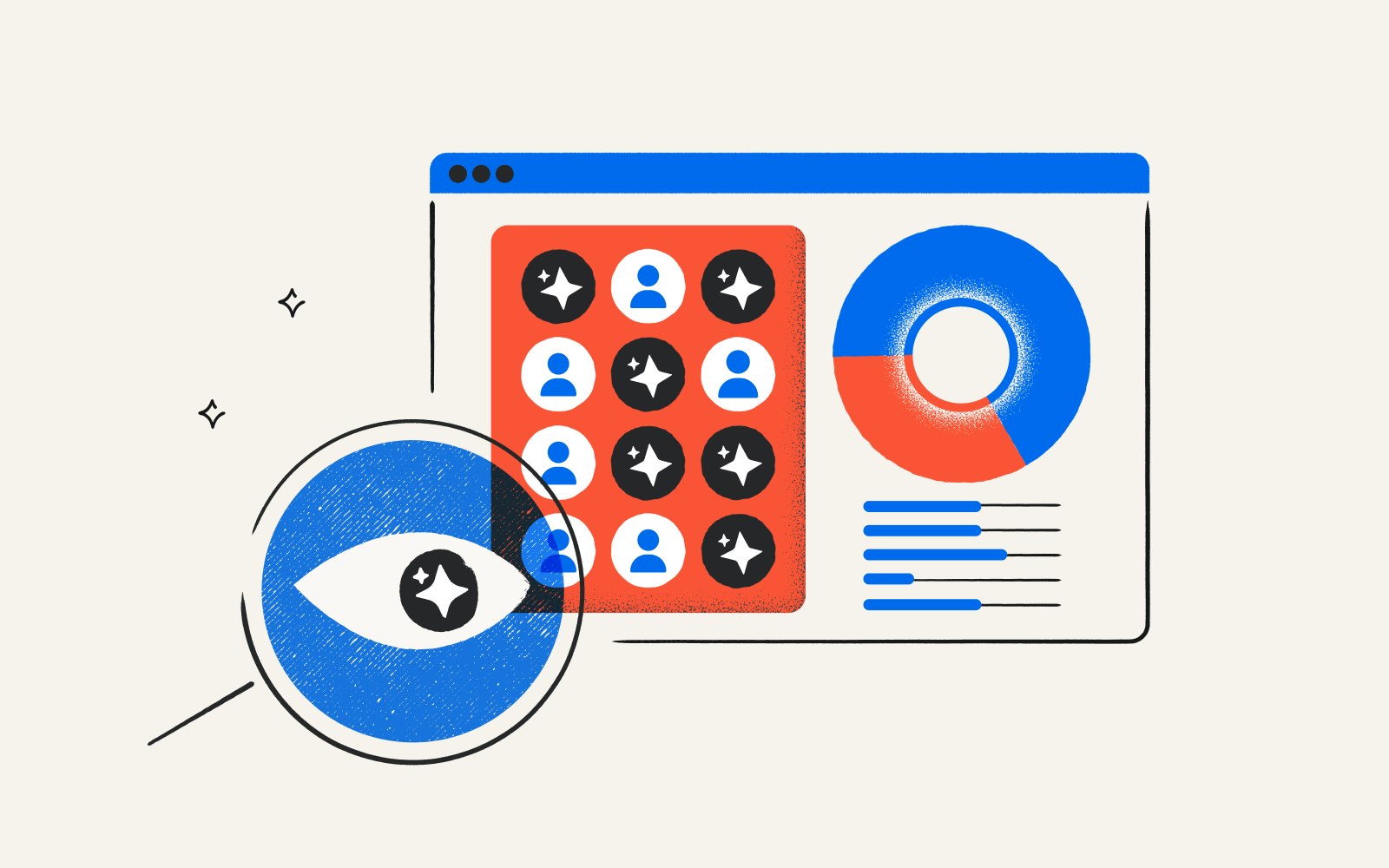The ultimate guide to market research survey methodologies
By Laura Ojeda Melchor ●10 min. read●Dec 16, 2025

Running a market research survey is one of the best ways to gather reliable insights from a target audience. But there's more to it than plugging questions into a survey template and hitting send.
Before you start, you need to know two things: what type of insights you're after, and which survey methodology will help you get them.
If you need to gauge broad audience reactions to a product idea, an online survey might be the right fit. If you want to dig deep into consumer attitudes and behaviors, a focus group could generate more detailed insights.
This guide breaks down the main market research survey methods, when to use each, and how to execute them effectively. By the end, you'll have a clear framework for choosing the right approach for your next study.
What is a market research survey?
A market research survey is a structured questionnaire used to collect data directly from a target audience. It helps marketing and product teams understand customer preferences, buying behaviors, and market trends to inform strategic decisions.
These surveys shed light on what customers actually think and want, acting as a roadmap for tailoring products and services to meet their needs.
Market research surveys aren't a one-and-done effort. Companies run them throughout a product or service's lifecycle, from early idea validation through post-launch optimization.
In the idea validation stage, surveys help determine whether there's a product-market fit before your stakeholders invest significant time and money.
Surveys also support messaging development, analyze how customers feel about existing products, and spot areas that need improvement. When it's time to innovate on a successful product, surveys can guide that evolution too.
The majority of market research surveys share some or all of these core goals:
Understanding customer preferences: Gather insights on what customers like and need so you can build customer profiles to guide targeting.
Informing strategic decisions: Use survey data to guide product development and improvements.
Identifying market demand: Find out if people actually want a new product concept or updates to existing offerings.
Gauging customer satisfaction: Measure how satisfied customers are with your products, services, and overall brand experience.
Understanding brand perception: Learn how customers perceive your brand and its values.
Segmenting the audience: Group customers based on demographics, behaviors, or preferences to support targeted research and strategy.
Why are market research surveys important?
Market research surveys give research teams direct access to what their target audience is thinking.
Some might argue that surveys are becoming less relevant as Big Data and behavioral data become more sophisticated. Companies can track how users browse the web, which content they engage with, and what preferences they signal through their digital behavior.
With all this passive data available, are surveys even relevant?
Yes. Behavioral data shows what people do. Surveys reveal why they do it.
Passive data can tell you that visitors abandoned their cart on the checkout page. It can't tell you whether they left because of shipping costs, trust concerns, or a confusing interface. That’s where you need surveys.
For research teams tasked with understanding motivations, preferences, and attitudes, that distinction matters. Behavioral or passive data can inform hypotheses, but surveys let you test them directly with your target audience, in their own words.
How to conduct a market survey: A step-by-step guide
Running a successful market research survey requires a clear process from start to finish. Here's a step-by-step framework to guide your next study.
1. Define your research objectives
Start by clarifying what you want to learn. Are you validating a product concept? Measuring brand awareness? Understanding purchase drivers? Your goals will shape every decision that follows, from methodology to question design. Work with stakeholders to align on specific, measurable objectives before moving forward.
2. Choose your survey methodology
Different research questions call for different approaches. Online surveys work well for broad, quantitative data collection. Focus groups and in-depth interviews are better suited for exploratory research where you need rich, qualitative insights. Consider your timeline, budget, and the depth of information you need when selecting a method.
3. Identify your target audience
Define who you need to hear from. Develop screening criteria based on demographics, behaviors, or other characteristics relevant to your study. The more precisely you define your target audience, the more actionable your findings will be. Create participant personas to guide recruitment and keep your team aligned on your ideal audience.
4. Design your questionnaire
Build your survey or interview guide to directly address your research objectives. Keep questions clear and unbiased. Mix question types strategically: closed-ended questions for quantifiable data, open-ended questions for deeper context. Pilot your questionnaire with a small group for participants before full deployment to catch confusing language or technical issues.
5. Plan your incentive strategy
Research incentives boost response rates and help attract better qualified participants. Cash, gift cards, and charitable donations are all common options, with cash being the top pick for most participants. Match your incentive value to the time and effort required from respondents.
6. Recruit participants
Source respondents who match your screening criteria. Depending on your study, you might recruit from an existing panel, use social media outreach, partner with a third-party recruiting agency, or tap into your own database. Vet participants carefully to protect data quality. Screener surveys, behavioral flags, and verification tools help filter out irrelevant profiles and bad actors before they enter your study.
7. Field the survey
Launch your study and monitor responses as they come in. Watch for completion rates, drop-off points, and any technical issues. If you're running a qualitative study, ensure moderators are prepared and recording / transcription tools are working.
8. Analyze and act on the data
Once data collection is complete, clean and analyze results. (AI tools can help.) Look for patterns, segment responses by audience characteristics, and tie findings back to your original objectives. Translate insights into clear recommendations for stakeholders, and document methodology details for future reference.
Types of market research surveys
Market research surveys generally fall into two broad categories: quantitative and qualitative. Understanding the difference helps you choose the right approach for your research objectives.
Quantitative surveys collect structured data from a large sample size. They're designed to answer questions like "how many," "how often," and "what percentage." Results are statistically measurable and can be generalized to a broader population. Examples include customer satisfaction surveys, brand awareness studies, and concept testing questionnaires.
Qualitative surveys explore attitudes, motivations, and behaviors in depth. They answer "why" and "how" questions through open-ended responses, discussions, and observation. Sample sizes are smaller but insights are richer. Focus groups, in-depth interviews, and ethnographic research fall into this category.
Many research programs combine both approaches. A quantitative survey might reveal that 60% of respondents prefer a new product concept. Qualitative follow-up research can then uncover why they prefer it and what specific features drive that preference.
Beyond the quantitative/qualitative distinction, surveys can also be categorized by their purpose:
Exploratory surveys help you understand a problem or opportunity when you don't yet have a clear hypothesis. They're useful in early-stage research to identify themes and generate ideas.
Descriptive surveys measure and describe characteristics of a population, such as demographics, preferences, or behaviors. They answer "what is" questions with concrete data.
Causal surveys test cause-and-effect relationships. They answer the “why” and help determine whether a specific variable (like price or messaging) influences an outcome (like purchase intent).
Market research survey methods and techniques
Once you know what type of insights you need, the next step is choosing the right data collection method. Each technique has distinct strengths depending on your timeline, budget, audience, and research objectives.
Online surveys
Online surveys are an efficient way to collect data from a large audience. Respondents complete questionnaires on their preferred device, and researchers can import responses directly into a secure database. Many survey platforms include tools for survey creation, distribution, storage, and analysis in one place.
How it works: Research teams send a set of questions to a targeted group of respondents who complete the survey at their convenience. Questions can include multiple-choice, rating scales, or open-ended formats. Once responses are collected, researchers analyze the data to identify patterns and develop recommendations.
Benefits: Online surveys are fast, cost-effective, and scalable. They offer flexibility for both researchers and respondents, which typically leads to higher completion rates. They're ideal for studies that require a large sample size or quick turnaround.
Where to start: Define your research objectives and draft a questionnaire with a mix of question types.
Telephone surveys
Telephone surveys involve calling respondents directly to ask a series of structured questions. While less common than online methods, they remain valuable for certain audiences and research contexts.
How it works: Researchers compile a list of phone numbers for their target audience and call each respondent to conduct the survey. Interviewers follow a prepared script but can probe for clarification or additional detail when needed.
Benefits: Telephone surveys allow for real-time dialogue to clarify responses and capture nuance. They're also effective for reaching populations that may not be comfortable or have access to digital surveys.
Where to start: Develop a questionnaire aligned with your research objectives. Compile a contact list that fits your target demographic, ensuring your sourcing methods comply with regulations like the Telephone Consumer Protection Act (TCPA), General Data Protection Regulation (GDPR), and the Telemarketing Sales Rule (TSR).
Face-to-face interviews
Face-to-face interviews involve meeting with respondents in person or via video to conduct a structured conversation. They're more resource-intensive than other methods but can yield valuable qualitative insights.
How it works: Researchers meet with respondents individually at a facility, inside the respondent's home, or via video call. The interviewer asks a series of prepared questions while allowing room for organic follow-up based on responses.
Benefits: In-person discussions let researchers observe body language and nonverbal cues, adding depth to the data. The conversational format also allows for immediate follow-up questions, often surfacing insights that wouldn't emerge in a written survey.
Where to start: Design open-ended questions aligned with your research goals. Prepare a discussion guide that balances structure with flexibility to let conversations flow naturally.
Focus groups
Focus groups bring together a small group of participants to discuss a specific topic, product, or concept. A trained moderator guides the conversation while researchers observe the group dynamics and capture insights.
How it works: Recruit a small group of participants (typically 3-12) who represent your target audience. A moderator leads the discussion through a series of questions designed to spark conversation. Researchers observe the session, often behind one-way mirrors or via video recording, to capture reactions and interactions.
Benefits: Focus groups reveal how people think and communicate about a topic in a social setting. Group dynamics can surface perspectives and reactions that don't emerge in one-on-one interviews. They're especially useful for exploring perceptions, testing messaging, and generating new ideas.
Where to start: Identify and recruit participants who match your target audience criteria. Prepare a discussion guide with questions designed to generate conversation. Hire a skilled moderator to lead the session and consider recording for later analysis.
Observational research
Observational research involves watching how people behave in real-world settings without direct intervention. Researchers observe natural behaviors and interactions rather than relying on self-reported data.
How it works: Define the specific behaviors or interactions you want to observe, then select an appropriate setting. Record behaviors of interest, either openly (where participants know they're being observed) or covertly (without the participant's knowledge). Ethical and legal considerations are critical when designing observational studies.
Benefits: Observational research captures authentic behavior rather than stated preferences or recalled actions. It can reveal patterns participants themselves may not be aware of or might not accurately report.
Where to start: Define your research objectives and the behaviors you want to observe. Determine the setting and whether participants will be informed. Establish protocols for recording and analyzing observations.
Panel surveys
Panel surveys collect data from the same group of respondents over an extended period. This approach allows researchers to track changes in attitudes, behaviors, or conditions over time.
How it works: Researchers recruit a group of respondents who agree to participate in multiple surveys at regular intervals (monthly, quarterly, or annually). The same or similar questions are asked at each wave to measure how responses evolve.
Benefits: Panel surveys reveal trends and shifts that single studies can't capture. They're valuable for tracking the impact of market changes, product launches, or external events on consumer attitudes and behaviors.
Where to start: Define your research objectives and the timeline for data collection. Recruit a panel that represents your target audience and plan a schedule for survey waves. Keep panelists engaged with regular communication and appropriate incentives to encourage them to keep participating.
Market research tools you’ll need for your survey
Once you’ve locked in your methodology, you’ll need the right tools to recruit participants, collect quality data, and deliver incentives. Here are the core categories research teams rely on.
Survey platforms: General-purpose tools like SurveyMonkey and Google Forms handle straightforward studies. Enterprise platforms like Qualtrics and Alchemer offer advanced logic and integrations for complex research. For in-product feedback, tools like Sprig deploy surveys directly within digital experiences. Community platforms like Alida and Fuel Cycle provide dedicated panels for ongoing research programs.
Recruitment channels: Paid panel providers like Prolific, Cint, and Dynata offer pre-recruited respondents across demographics. Email and LinkedIn outreach works well for B2B or niche audiences. Intercept surveys capture in-the-moment feedback from website or app users. Research communities provide engaged participants for repeat studies.
Incentive and payout tools: Look for platforms with diverse redemption options (gift cards, prepaid cards, cash equivalents, donations) and global delivery for international studies. Incentive platforms like Tremendous offer 2,500+ redemption options in over 230 regions with built-in fraud prevention tools.
Quality and fraud prevention: Questionable survey data has grown to 30-40% in recent years, driven by AI-powered bots and human fraudsters using generative AI tools. Build controls directly into your surveys. Survey-level detection platforms like Rep Data, Verisoul, and Roundtable, and OpinionRoute flag bot patterns and behavioral anomalies. Open-end analysis tools like ReDem and Research Defender catch AI-generated text. Response timing checks flag suspiciously fast completions, attention validators catch inattentive participants, and open-end reviews identify gibberish or scripted responses. Deduplication tools and digital fingerprinting help block repeat bad actors across studies. For a deeper look at proven detection methods and the latest tools, read our Report: Research fraud prevention: How to build your tech stack report with Escalent.
Analysis tools and techniques: Crosstabs and significance testing reveal meaningful differences across segments. Basic segmentation helps you slice data by demographics or behaviors. Post-collection cleaning tools like Clean ID use natural language processing (NLP) to flag off-topic or restated responses. AI-powered tools can also speed up open-end response coding, turning qualitative data into quantifiable themes.
Which survey method makes sense for you?
Choosing the right survey method comes down to balancing four key tradeoffs: speed, cost, sample size, and depth of insight. Here are examples of how common research scenarios map to specific methods:
| Research goal | Method | Example |
|---|---|---|
| Test a new product concept | Online survey | A CPG company surveys 500 consumers on flavor preferences and purchase intent before investing in production |
| Understand why customers are churning | In-depth interviews | A subscription service interviews 15 churned customers to uncover pain points not visible in behavioral data |
| Evaluate ad messaging before launch | Focus groups | A retail brand runs two focus groups to test emotional reactions to three campaign concepts |
| Track brand perception over time | Panel survey | A financial services company polls the same customers quarterly to measure how a rebrand affects sentiment |
| Observe in-store shopping behavior | Observational research | A grocery chain records how shoppers navigate a new store layout to inform merchandising decisions |
Key takeaways
Market research surveys matter: Behavioral data shows what people do. Surveys reveal why. They remain one of the most reliable ways to capture attitudes, preferences, and motivations from your target audience.
Start with clear objectives: Define what you need to learn before selecting a methodology. Your research goals shape everything from question design to recruitment strategy.
Match method to objective: Online surveys offer speed and scale for quantitative data. Focus groups and interviews deliver depth for exploratory research. Panel surveys track shifts over time.
Invest in the right tools: Survey platforms, recruitment channels, incentive solutions, and fraud prevention tools all play a role in study success. Build your stack based on research complexity and audience.
Protect data quality: Bad actors are getting more sophisticated. Layer multiple safeguards throughout your study to catch fraudulent responses before they compromise your data.
Incentives are essential: No matter what survey methodology you choose, participants expect something in return for their time. The right incentive boosts response rates, attracts quality respondents, and keeps panelists engaged for future studies.
Need to send research incentives fast, globally, and without worrying about fraud? See how Tremendous can help.


